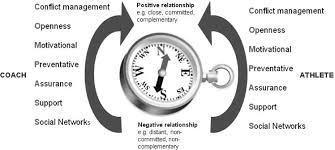The coach- athlete relationship
We have found that it takes a long time to build the relationship and learn everyone’s name especially when you need to try and learn 60+ names. From my experience having little 1 to 1 time with the students wether thats giving feedback, encouraging or explaining something this helps to build the relationship and you can find out their name and have that time with them. Even something little as a high five helps to build the relationship as you have contact time with the student and it helps them feel like they are special and helps them feel motivated (Morris et al., 2014). However it has been difficult to build this relationship due to various reasons. Therefore, it has been very inconsistent and affected the amount of time spent coaching the children.
Theory the 3cs
Participants often look at their coaches as parents which is built through trust (Jowett et al., 2003). This is often built over time to be able to create this quality relationship. When looking at the 3CS this is looking at the Closeness, Commitment and Complementarity (Jowett, 2007). This shows that the students need to have trust each other and respect each other in order to build a close relationship. Commitment requires both us as coaches to turn up to placement every Friday and deliver our sessions but also the students to turn up to our sessions. Complementarity is where both the coaches and the students will have fun and try their best to try and improve at a skill.

COMPASS Model
The COMPASS model (Rhind et al., 2010) shows how coach and athletes get and maintain a relationship in order for it to be a positive relationship. Showing that both the coaches and the students need to be good at all the qualities on the side e.g. commitment to have a positive relationship. One key element is that we do need to be supportive towards the students. This is important as the students might not have a great quality home life so when they come to school it is important that the students feel safe, happy and supported by staff and peers.

What happened next?
From this research we tried being more supportive with the students and being more motivational to try and improve our relationship with the students. To be supportive towards the students we spent more time talking to them if they looked sad or they decided to sit out. We spent more time teaching 1 to 1 with the students to try and improve their techniques of the skills being taught. However it is still difficult to split your time and spend time with the students as there are 25+ kids in each class and they all have different needs. But with more sessions we will get better at this. 1 to 1 was useful when we had 1 child sat out and we took a small amount of time with the child who raised their concerns about the activity. But once giving some encouragement they joined in and enjoyed the activity. The child then said that they liked the fact that coaches are coming to talk to them and like the little high fives as it makes them feel special and happy.
References
Morris, B.J. and Zentall, S.R., (2014). High fives motivate: The effects of gestural and ambiguous verbal praise on motivation. Frontiers in psychology, 5, p.928.
Jowett, S. and Cockerill, I.M., (2003). Olympic medallists’ perspective of the althlete–coach relationship. Psychology of sport and exercise, 4(4), pp.313-331.
Jowett, S. (2007). Interdependence analysis and the 3+1Cs in the coach-athlete relationship. In S. Jowett & D. Lavallee (Eds.), Social psychology in sport (pp. 15–27). Champaign, IL: Human Kinetics.
Rhind, D.J. and Jowett, S., (2010). Relationship maintenance strategies in the coach-athlete relationship: The development of the COMPASS model. Journal of applied sport psychology, 22(1), pp.106-121.